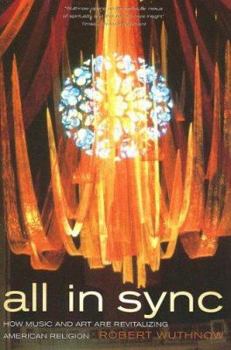All in Sync: How Music and Art Are Revitalizing American Religion
Select Format
Select Condition 
Book Overview
Robert Wuthnow shows how music and art are revitalizing churches and religious life across the nation in this first-ever consideration of the relationship between religion and the arts. All in Sync... This description may be from another edition of this product.
Format:Paperback
Language:English
ISBN:0520246853
ISBN13:9780520246850
Release Date:January 2006
Publisher:University of California Press
Length:304 Pages
Weight:0.99 lbs.
Dimensions:0.7" x 6.1" x 9.0"
Customer Reviews
1 rating
Arts and graces
Published by Thriftbooks.com User , 19 years ago
This book by Robert Wuthnow, professor of social sciences and Director of the Centre for the Study of Religion at Princeton University, draws upon extensive research, including interviews with more than 400 people involved in a diverse number of worship settings across the country. In this study, Wuthnow documented a strong connection between interest in the arts and interest in spiritual growth. Americans are fundamentally a religious, spiritual people. 'Spirituality is deeply significant to most Americans. Despite the materialism that surrounds us, the quest to know God and to experience the sacred has not diminished,' according to Wuthnow. However, this quest does not always happen within the confines of the institutional church - increasingly, people are looking for other ways of making connections with God. Music and art are part of this quest, but often overlooked, save in the most formal of ways. There is an undercurrent of Protestant/Puritan mistrust of images, many kinds of artwork, and many types of music. One would think in this media-saturated culture that people would not lack for images, sounds, and words to experience, but this is part of the problem, according to Wuthnow. 'Although mass media make it easy for Americans to explore the arts, the results of such explorations are often disappointing. Media-fed spirituality suffers from superficiality, while momentary inspiration fails to illumine the dark night of the soul.' Wuthnow explores the overall religious identity of the United States, looking at statistical studies and trends since the post-World War II period. He shows growth in different ways (more people identifying themselves as conservative and as liberal religiously, more interest in spirituality vs. historic religious institutions, etc.) but also asks questions regarding the basis of these trends. Wuthnow shows that the arts play a great deal of importance in spirituality trends, including music, television, film, theatre, museum and formal 'arts' shows, and publishing. Wuthnow argues in this book 'that the vitality of America's churches may depend significantly on the public's growing interest in artistic activities.' Wuthnow admits that some may find this argument a stretch, but in his subsequent chapters, he does give interesting argument for support. Wuthnow's text deals with issues in art, spirituality, imagination, liturgy and worship, problems of conflict between the arts and the churches, and the awakening of the artistic soul in every person. We live in a consumer society, and this approach is often found with regard to understanding the arts, too. 'Because it is easier to be consumers of art than to create it, it is all the more important to emphasise that art is a strong form of personal discipline.' As Wuthnow states, it is not that Americans are averse to work (indeed, quite the opposite), but that the arts have always been relegated to that arena of life that is a hobby, a value-add





